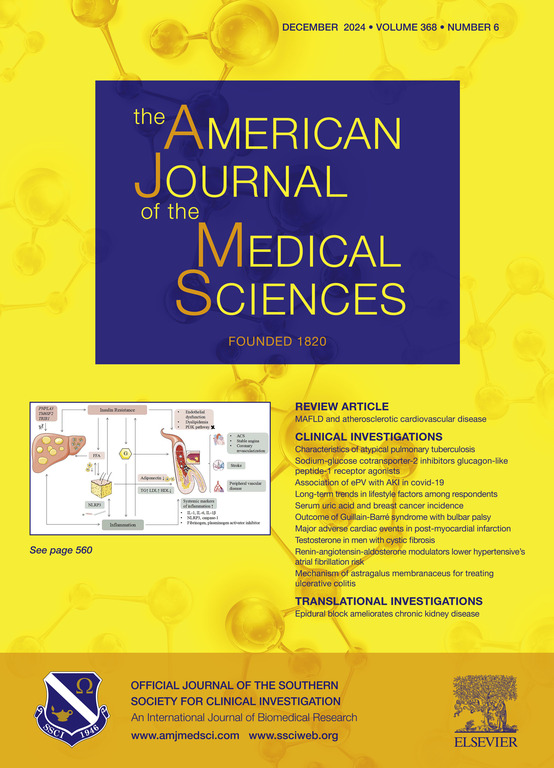Characteristics of atypical pulmonary tuberculosis without typical clinical features diagnosed by pathology
IF 2.3
4区 医学
Q2 MEDICINE, GENERAL & INTERNAL
引用次数: 0
Abstract
Purpose
Some patients with pulmonary tuberculosis (PTB) do not display typical clinical features, leading to delays in diagnosis and treatment.
Methods
We retrospectively analyzed PTB patients admitted to the Second Affiliated Hospital of Chongqing Medical University between 2017 and 2020. They are divided into pathological group (diagnosed through pathological biopsy) and control group (diagnosed via sputum or lavage fluid). Clinical data of both groups were compared. Based on radiographic features, the pathological group was further divided into the inflammation group, peripheral nodule group, and central occupancy group. We then statistically analyzed the computed tomography (CT) signs, bronchoscopic manifestations and results of pathological biopsy for each subgroup.
Results
The pathological group consisted of 75 patients, while the control group had 338 patients. Multivariate logistic regression analysis showed that the pathological group had more diabetes (OR = 3.266, 95% CI = 1.609–6.630, P = 0.001), lower ESR (OR = 0.984, 95% CI = 0.971–0.998, P = 0.022), and lower CRP (OR = 0.990, 95% CI = 0.980–0.999, P = 0.036). In the three subgroups, the exudative lesions in the inflammation group were mostly located in atypical areas of PTB. The lobulation sign and spiculation sign were frequently observed in the peripheral nodule group. All presented with significant hilar mediastinal lymphadenopathy in the central occupancy group. In the pathological group, bronchoscopic manifestations typically included mucosal edema and bronchial stenosis.
Conclusion
Diabetes is an independent risk factor for atypical PTB. Expression of erythrocyte sedimentation rate (ESR) and C-reactive protein (CRP) in atypical PTB is low. Radiologically, it is most easily misdiagnosed when presented as peripheral solid nodules or masses, so a biopsy is recommended.
通过病理学诊断的无典型临床特征的非典型肺结核的特征。
目的:部分肺结核(PTB)患者未表现出典型的临床特征,导致诊断和治疗延误:我们对重庆医科大学附属第二医院2017年至2020年间收治的PTB患者进行了回顾性分析。将其分为病理组(通过病理活检确诊)和对照组(通过痰液或灌洗液确诊)。两组患者的临床数据进行比较。根据放射学特征,病理组又分为炎症组、周围结节组和中心占位组。然后,我们对每个分组的计算机断层扫描(CT)体征、支气管镜表现和病理活检结果进行了统计分析:结果:病理组有 75 名患者,对照组有 338 名患者。多变量逻辑回归分析显示,病理组中糖尿病患者较多(OR=3.266,95%CI=1.609-6.630,P=0.001),ESR较低(OR=0.984,95%CI=0.971-0.998,P=0.022),CRP较低(OR=0.990,95%CI=0.980-0.999,P=0.036)。在三个亚组中,炎症组的渗出性病变大多位于 PTB 的非典型区域。外周结节组常出现分叶状征和棘突征。在中央占位组中,所有病例都有明显的纵隔淋巴结病变。在病理组中,支气管镜表现通常包括粘膜水肿和支气管狭窄:结论:糖尿病是非典型性肺结核的独立危险因素。非典型 PTB 中红细胞沉降率(ESR)和 C 反应蛋白(CRP)的表达较低。从放射学角度看,如果表现为周围实性结节或肿块,最容易被误诊,因此建议进行活组织检查。
本文章由计算机程序翻译,如有差异,请以英文原文为准。
求助全文
约1分钟内获得全文
求助全文
来源期刊
CiteScore
4.40
自引率
0.00%
发文量
303
审稿时长
1.5 months
期刊介绍:
The American Journal of The Medical Sciences (AJMS), founded in 1820, is the 2nd oldest medical journal in the United States. The AJMS is the official journal of the Southern Society for Clinical Investigation (SSCI). The SSCI is dedicated to the advancement of medical research and the exchange of knowledge, information and ideas. Its members are committed to mentoring future generations of medical investigators and promoting careers in academic medicine. The AJMS publishes, on a monthly basis, peer-reviewed articles in the field of internal medicine and its subspecialties, which include:
Original clinical and basic science investigations
Review articles
Online Images in the Medical Sciences
Special Features Include:
Patient-Centered Focused Reviews
History of Medicine
The Science of Medical Education.

 求助内容:
求助内容: 应助结果提醒方式:
应助结果提醒方式:


